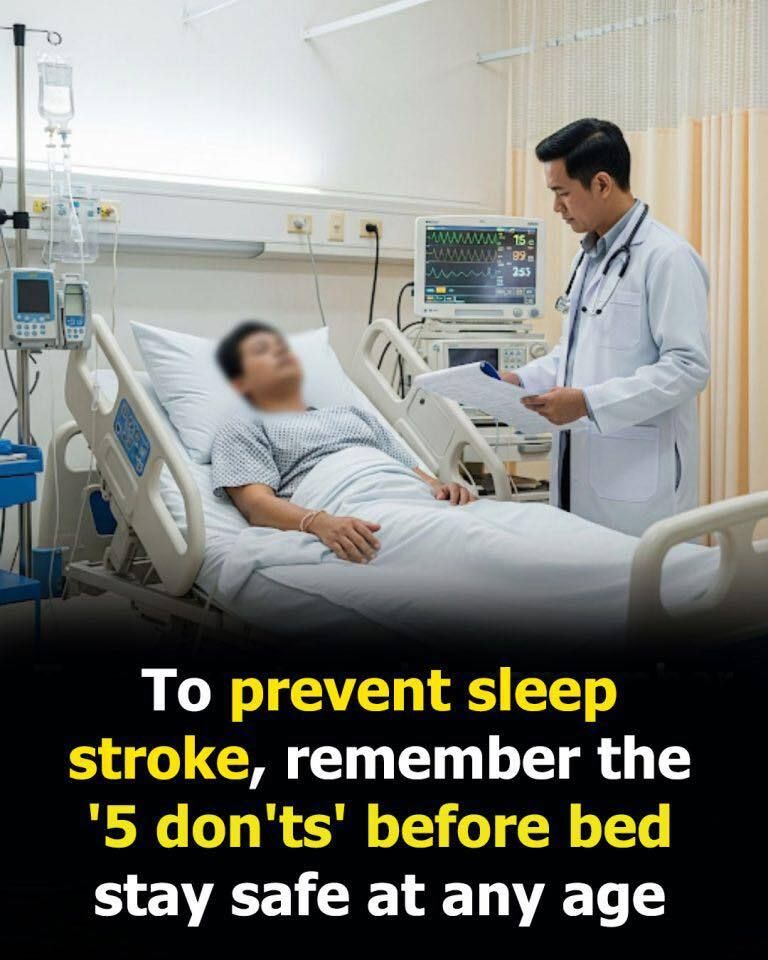A sleep stroke, medically referred to as a “wake-up stroke,” is a serious cerebrovascular event that occurs when blood flow to the brain is interrupted, either by a blocked artery or a ruptured blood vessel, during the night while a person is asleep. Unlike strokes that happen during the day, sleep strokes often go unnoticed until the affected individual wakes up, which can be dangerous because it delays medical attention and increases the likelihood of severe, long-term neurological damage. Experts emphasize that recognizing the risk and understanding preventive measures are crucial for protecting both brain and heart health.
Why They’re Dangerous
Sleep strokes are particularly dangerous because the window for effective treatment is very narrow. Every minute counts when it comes to restoring blood flow to the brain and minimizing damage. By the time a person wakes and recognizes symptoms, critical hours may have already passed, making interventions like clot-busting medications or surgical procedures less effective. The consequences of a delayed response can be devastating, including permanent paralysis, speech difficulties, cognitive impairments, and in severe cases, death.
Recognizing the Warning Signs
Early recognition of stroke symptoms is vital. Common signs include sudden numbness or weakness on one side of the body, slurred or garbled speech, confusion, blurred or double vision, dizziness, sudden loss of balance, severe headache, nausea, or seizures. Because these symptoms often appear only upon waking, it is essential for both individuals and their families to remain vigilant and respond immediately if anything unusual occurs.
The FAST Rule Saves Lives
Medical professionals recommend using the “FAST” rule to quickly identify potential strokes. F stands for Face drooping, A for Arm weakness, S for Speech difficulty, and T emphasizes the importance of Time—calling emergency services without delay. Rapid recognition and swift action can significantly improve outcomes and reduce the long-term physical and cognitive effects of a stroke.
Preventive Habits Before Sleep
Prevention begins before bedtime. Maintaining healthy evening routines is key to reducing stroke risk. Avoiding heavy meals, excess salt, alcohol, and smoking in the hours leading up to sleep helps prevent spikes in blood pressure, which are known to contribute to cerebrovascular events. Creating a calm environment for sleep also supports heart and brain health.
Managing Stress at Night
Stress management is another important factor. Exposure to screens and overstimulation before bed can hinder the body’s natural relaxation processes. Practicing calming activities such as reading, meditating, or gentle stretching can reduce stress hormones, improve sleep quality, and lower cardiovascular strain, thereby helping to protect against nighttime strokes.
Building a Healthy Sleep Routine
Maintaining consistent, restorative sleep of seven to nine hours each night is crucial. Staying lightly hydrated, taking prescribed medications as directed, and using CPAP devices for sleep apnea patients can all help mitigate stroke risk. A structured nighttime routine not only promotes better rest but also supports overall cardiovascular and brain health.
Lifestyle Choices That Make a Difference
Small lifestyle adjustments can have a big impact. Regular physical activity, balanced nutrition, and avoidance of harmful substances all contribute to a stronger heart and vascular system. Incorporating mindful relaxation techniques in the evening, such as slow breathing or light yoga, can further enhance resilience against stress-related health risks.
The Role of Evening Habits
Even simple practices like a short walk after dinner or winding down with a quiet hobby can be surprisingly effective. These routines help regulate blood pressure, improve circulation, and prepare the body for restorative sleep, which in turn lowers the risk of nocturnal strokes. The key is consistency and awareness of the subtle factors that can influence vascular health overnight.
Final Thoughts
By understanding the hidden dangers of sleep strokes and adopting proactive nighttime habits, individuals can significantly reduce their risk. Awareness of symptoms, adherence to preventive routines, and timely response to emergencies are all vital. A few conscious steps each evening—healthy meals, stress reduction, physical activity, and adequate sleep—can protect not only your brain but your entire body from the devastating consequences of a stroke.
A sleep stroke, or “wake-up stroke,” happens when blood flow to the brain is blocked or a vessel bursts during sleep. Symptoms often appear only upon waking, which can delay treatment and worsen outcomes. Awareness is key to early intervention.
These strokes are dangerous because timely treatment is critical. Hours lost during sleep can make medications or surgery less effective, increasing the risk of permanent damage or death.
Warning signs include sudden numbness, weakness, slurred speech, confusion, vision changes, dizziness, severe headache, or nausea. Recognizing these signs immediately can save lives.
The “FAST” rule helps identify strokes: Face drooping, Arm weakness, Speech difficulty, and Time to call emergency services. Acting quickly can reduce long-term damage.
Preventive bedtime habits are important. Avoiding heavy meals, salt, alcohol, and smoking can lower blood pressure and decrease stroke risk during the night.
Managing stress before bed also matters. Calming activities like reading, meditation, or light stretching help relaxation, improve sleep, and protect cardiovascular health.
A healthy sleep routine of 7–9 hours is recommended. Staying hydrated, following medications, and using CPAP for sleep apnea can protect the brain and heart from nighttime stroke risks.
Lifestyle choices, such as exercise, balanced nutrition, and avoiding harmful substances, support vascular health. Mindful evening routines enhance relaxation and lower stress levels.
Simple evening habits like walking after dinner or quiet hobbies help regulate blood pressure and prepare the body for restorative sleep, reducing nocturnal stroke risk.
By combining symptom awareness, preventive routines, and timely action, individuals can lower the hidden dangers of sleep strokes. Consistent healthy habits are vital for brain and heart protection.
